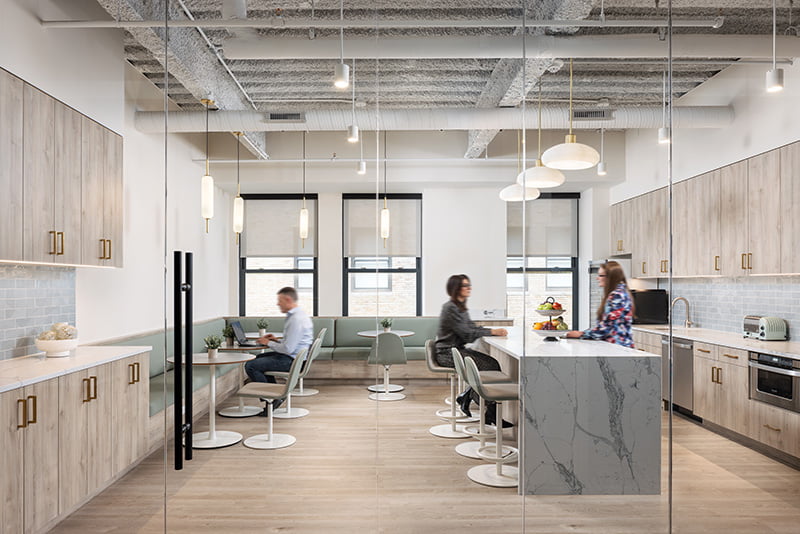
01 Apr 5 RTO Trends Shaping Office Design in 2025
At RI Workplace, we’ve spent over 30 years designing office environments that inspire productivity, collaboration, and well-being. But over the past five years, the concept of the workplace has undergone a dramatic shift: from remote work to hybrid models and now, a new wave of return-to-office (RTO) mandates.
As businesses navigate this evolving landscape, office attendance has now hit its highest level since the pandemic. According to recent Kastle Systems’ data, office occupancy in 10 major U.S. cities reached 54.5% of pre-pandemic levels in early March 2025, surpassing the previous peak in January. This increase comes as major corporations like Amazon, Starbucks, Disney, AT&T, Dell Technologies, and JPMorgan Chase double down on in-office work policies.
But RTO isn’t just about getting employees back into buildings. CEOs and business leaders must consider what an office needs to be in this new era of work. How do we design spaces people actually want to work in? How do we encourage collaboration while respecting the flexibility employees have come to expect?
The answers lie in understanding the key trends shaping RTO, and designing workplaces that align with both business goals and employee satisfaction.
Let’s delve into the subject…

1. Office Attendance Hits Post-Pandemic High
For the first time since 2020, office attendance is reaching new heights. Cities including Chicago (56.3%), New York (55.1%), and Washington D.C. (52.8%) are leading the way, with Texas cities continuing to outperform national averages.
While attendance remains well below pre-pandemic levels, the gradual increase signals a shift. Employers are enforcing stricter in-office policies, and a stabilizing labor market gives companies more control over workplace mandates.
U.S. job openings totaled 7.7 million in January 2025, with retail and financial services seeing the biggest gains. While hiring remains steady, the power balance has shifted. With fewer job-switching opportunities, employees have less leverage to negotiate remote work.
What does this mean for office design? With more workers returning to in-person roles, it means companies must think about how their office environments support productivity, collaboration, employee personality types and employee well-being.
2. Big Tech’s Influence on RTO Mandates
The world’s biggest companies are shaping the RTO conversation. Amazon, Dell Technologies, and JPMorgan Chase have recently enforced stricter attendance policies, citing improved collaboration, innovation, and culture-building as key reasons.
A study by WFH Research found that most RTO policies require at least three days a week in the office. Interestingly, younger employees (ages 18-24) are more likely to embrace in-office work for career development, while older professionals prefer remote flexibility.
This generational divide means workplace design must cater to diverse needs and offer spaces for deep focus, collaboration, and social interaction.
3. Hybrid Work as the Middle Ground
While full-time remote work remains rare, hybrid models are now the standard. A 2024 CBRE survey found that 43% of employees in Europe now go into the office at least three days a week, up from 37% in 2023.
The key challenge? Balancing structured in-office requirements with employee autonomy. Workers still value flexibility, but they also recognize the benefits of face-to-face interaction for networking, mentoring, and company culture.
As a result, offices need more than just desks and meeting rooms—to be truly future ready, they must include collaboration hubs, social spaces, and quiet zones that support different workstyles.

4. The Impact on Commercial Real Estate and Infrastructure
As office attendance rises, companies are reevaluating their real estate strategies. While some businesses continue downsizing their office footprints, others are redesigning spaces to reflect new work habits.
Kastle Systems’ latest data shows office occupancy averaging 54.5%, a significant jump from pandemic lows. Yet, major cities like New York and Washington D.C. still struggle with underused office space.
This shift has ripple effects across infrastructure, from public transit ridership to corporate leasing decisions. For employers, the key takeaway is clear: optimizing office layouts is essential. A simple yet effective way to do this is by investing in adaptable, multi-functional furniture instead of traditional fixed workstations.

5. 5 Ways to Design Your Workplace for the RTO Era
With employees returning in higher numbers, office design must evolve. The modern workplace isn’t about forcing attendance; it’s about creating environments people actually want to be in. Spaces that incorporate the following are a must:
- Offer Flexible Workspaces – Open seating, private booths, and collaboration areas that allow employees to work in ways that suit them best.
- Deliver Technology-Enabled Work Environments – Smart meeting rooms, advanced video conferencing, and AI-powered analytics to enhance hybrid collaboration.
- Provide Wellness and Comfort – The offices of 2025 should include biophilic design (natural light, plants, and outdoor areas), ergonomic furniture, and wellness rooms as standard.
- Incorporate Hospitality-Inspired Spaces – Café-style seating, social hubs, and relaxed lounge areas that foster interaction and creativity.
- Embrace Commute-Friendly Features – To ease the return to in-office work, companies can offer commuter benefits, on-site fitness centers, and satellite office locations.
Final Thoughts
The five-day office workweek isn’t coming back FT, but in-office attendance is certainly climbing. The key to a successful RTO strategy lies in balancing business needs with employee expectations, which brings us to the physical workspace.
As companies bring people back, they must rethink how their offices function. A successful workplace should enhance collaboration, prioritize flexibility, and attract top new talent – and existing team members.
At RI Workplace, we help businesses design offices that work for the future with our Workplace Retreat Design Package.

Need to reimagine your space? Let’s talk.



















